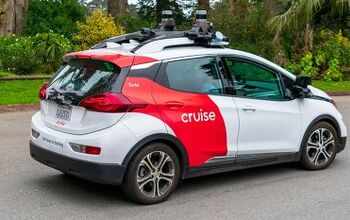No Fixed Abode: Five Amazing Things That Are Easier to Invent Than an Autonomous Car

It’s neither on-message for this site nor terribly interesting to my readers, which is why I rarely mention it, but I have been almost feverishly interested in matters of artificial intelligence, machine consciousness, and advanced language parsing for a very long time.
Thirty-five years ago, I tried to write a very simple sentence parser and response generator for the Atari 800 for my school science fair. The effort failed miserably, in large part because AtariBASIC didn’t really have any usable tools for text handling — and because I was nine years old and had the attention span of a fruit fly.
The night before the science fair, I admitted defeat and decided to do something else: I wrote a quick program that would give pre-programmed responses to certain questions.
The next morning, I demonstrated my program to a couple of nuns. I asked them a couple of leading questions to get them to pick the discussion topic I wanted, then I had them type the questions in. The amazingly intelligent Atari responded in full sentences! Not even the utter pathos of my quickly sketched cardboard sign behind it could keep me from getting an A+. What amuses me, in retrospect, was that the nuns weren’t really all that shocked at the idea that an 8-bit computer could parse language and give reasonable answers. Had I demoed this program to anybody who understood technology, they’d have labeled me a genius or a fraud. But to the nuns, passing the Turing test was about as tough as making an artificial volcano. Blame the movies, I guess.
The problem with every “autonomous” car that has appeared so far is simple: they are all equal to my childhood Atari program. Real autonomous operation is a hugely difficult problem. I’d like to illustrate this for you by listing five rather astounding technical feats that will be easier to accomplish than true vehicular autonomy.
My inspiration for this was simple. Fifteen years or so ago, the comedy Ur-website The Brunching Shuttlecocks did a feature (now disappeared) on “Monkeys, Hamlet, and You.” You’ve probably heard that an infinite number of monkeys banging away on an infinite number of typewriters would almost immediately produce the text of Hamlet, but this article listed a bunch of things that a nearly infinite number of monkeys would produce before they produced Hamlet, including:
- Several perfect cryptograms of Hamlet.
- A long Usenet argument over whether Boba Fett is alive, complete with spam-blocked e-mail addresses.
- The phrase “Jesus Christ my ass is chafed” repeated for the length of two letter-sized pages.
- The text of Hamlet, except everyone dies of food poisoning in Act II.
- A brief but accurate write-up of the most embarrassing thing you ever did, with full names, dates, and places.
- Hop on Pop
- The Denny’s Kids Menu.
- A short story entitled “Babysitter’s Passion.”
- “Iii pp98&(*(^9 879j; FF”
- The text of Hamlet, except that Horatio is named “Elvis.”
Some of you will immediately understand why all of those things would happen first — here’s a hint, “Elvis” is shorter than “Horatio”, and there are twenty-five possible cryptograms of Hamlet — but if you don’t understand, let me try to explain. A nearly infinite number of monkeys that each hit the keys of a typewriter a hundred times would instantly produce virtually all the possible legitimate English sentences of a hundred characters, but they would also produce all sorts of unrecognizable garbage that was 100 characters long. Extend to the length of Hamlet, and there you go.
Now, if you’re trying to create an autonomous car, along the way you’re going to accidentally solve problems that are “shorter” — which is to say, easier — than an autonomous car. I could go on about the thinking behind this statement, but it leads pretty quickly to stuff like “NP-complete” and “isomorphism”, so let’s go directly to the fun stuff. These are Five Amazing Things That Are Easier To Invent Than An Autonomous Car:
Number Zero: A Jumbo Jet Without a Pilot. This one’s cheating, because it effectively already exists. Modern passenger jets are all but autonomous as things sit now. The reason for this is simple: the skies aren’t very crowded and visual interpretation isn’t very important for aircraft. It’s far, far easier to follow a flight plan at 600 mph while dealing with everything from turbulence to incoming bird strikes than it is to, say, read the paint lines on a Chicago freeway during a snowstorm. Long before we can safely let a car drive from Joliet to the Miracle Mile in the winter, we’ll be able to let a 500-passenger jumbo go from jetway to jetway without a human being. Whether we’ll feel good about it is another question.
Number One: The Best Radiation Oncologist in History. I have a lot of respect for radiation oncologists: their job is tough and it involves a lot of life and death decisions. But you could train an expert system to do the job simply by having it “watch” a few thousand oncologists make decisions. Interpreting X-rays is far easier than gauging the available traction of the road ahead. And while you might not trust a robot to tell you if you have cancer, it’s going to be as good as its job as the best available human doctor — better, actually.
Number Two: A Mind-Reading Robot, as Far as You Can Tell. Facial recognition and parsing is tough work, but it’s not as tough as interpreting a Manhattan surface street at rush hour. The day is coming quickly when a robot will be able to watch your face for a short while and learn all the unconscious tics and expressions that betray your inner state, your truthfulness, and your near-term plans for action. And a laser microphone can pick up your subvocalizations pretty easily. The technology to “read” what you unconsciously subvocalize is well underway. Before long, you won’t have any secrets from any machine that can see your face — even through a window, or at a distance.
Number Three: A Completely Automated Fast-Food Restaurant. Imagine walking up to a set of man-height Golden Arches sitting pretty much anywhere in a city, having a pleasant conversation with a very real-looking person on a screen, then receiving your food from a sliding tray beneath that screen. All the technology is already present; it just needs a bit of refining. An underground module about the size of a 10′ x 10′ room could automatically prepare, cook, and package your meal without human intervention. Believe it or not, the biggest obstacle to doing it is customer stupidity. When I was in Barcelona last year, I visited a McDonald’s with no human order-takers — and I saw people repeatedly fail to operate the ordering system properly, even though it was simple enough for a five-year-old. What’s required is natural-language interpretation, which is progressing faster than autonomous-car visual recognition. We’re pretty close to the Idiocracy self-serve restaurant.
Number Four: Almost All the Nightmare Stuff From the Terminator Movies. No, we won’t have “liquid metal” any time soon, at least not like in the movies. But war fighting is a considerably simpler exercise than driving in a city. Consider how much simpler a tank’s job is than a taxi’s job would be: drive over anything that won’t blow up and shoot anything that looks like the enemy. The same is true for drones or bombers: fly past the front lines and kill everything that matches a particular profile. We’re already at the stage of aerial combat where most kills take place past the limits of human vision. So why have the humans? In the war of the future, everybody and everything will carry an IFF (Identification Friend or Foe) device that works on the same principle as the RSA SecureID devices given to cubicle drones. Except the codes will change every second, not every ten minutes, and if you aren’t broadcasting the right code you’ll be marked for death, pronto. Again, I cannot adequately express the difference in complexity between, say, a bomber mission where the plane stays within 100 feet of the terrain at supersonic speed and your daily commute. The latter is much, much more computationally complex.
And that’s our list. But I’d be remiss if I didn’t point out that I deliberately omitted one important thing: long before it will be safe to let computers drive people around, it will be considered safe to let computers drive themselves around. You’ll have everything from pizzas to bank deposits transmitted via autonomous vehicles that are biased towards self-sacrifice. It’s a much simpler problem from a computing perspective if you always assume that your existence is less valuable than the existence of the vehicles and people around you.
The Amazon self-driving motorcycle courier will be programmed to swerve into a wall and not come into contact with a pedestrian or a wayward human-driven automobile. The hardest computing problem of all isn’t visual recognition or traction mapping; it’s ethics. Which leads to the question: Should we be teaching computers to make ethical decisions? And if we should, who among us is qualified to teach?
[Image: Uber]

More by Jack Baruth
Latest Car Reviews
Read moreLatest Product Reviews
Read moreRecent Comments
- Doug brockman There will be many many people living in apartments without dedicated charging facilities in future who will need personal vehicles to get to work and school and for whom mass transit will be an annoying inconvenience
- Jeff Self driving cars are not ready for prime time.
- Lichtronamo Watch as the non-us based automakers shift more production to Mexico in the future.
- 28-Cars-Later " Electrek recently dug around in Tesla’s online parts catalog and found that the windshield costs a whopping $1,900 to replace.To be fair, that’s around what a Mercedes S-Class or Rivian windshield costs, but the Tesla’s glass is unique because of its shape. It’s also worth noting that most insurance plans have glass replacement options that can make the repair a low- or zero-cost issue. "Now I understand why my insurance is so high despite no claims for years and about 7,500 annual miles between three cars.
- AMcA My theory is that that when the Big 3 gave away the store to the UAW in the last contract, there was a side deal in which the UAW promised to go after the non-organized transplant plants. Even the UAW understands that if the wage differential gets too high it's gonna kill the golden goose.


































Comments
Join the conversation
I would invest a modest amount in a company that would invent a car rental place where I don't have to interact with people, who type my details into computers slower than my mother "the flash" (she never hits the same keys twice). I imagine an online registration process, and a sort of key vending machine, where I only have to insert my credit card (or touch my phone) and *clink* a key pops out with a text to my phone with the position of the car.
"The effort failed miserably, in large part because AtariBASIC didn’t really have any usable tools for text handling" Actually, the Atari BASIC (or any BASIC) probably was the best tool for string handling at the time (unless you had access to MIT machines and LISP or something). But it wasn't all that good at letting you build up from that. Subroutines simply added spagetti code and overwrote global variables, so good luck turning string handling into text parsing. To be honest, had you typed in "Eliza" from BASIC Computer Games* (and fixed things since ATARI strings needed sizes, but MSBASIC didn't. I can only imagine the frustration of a 9-year old typing something in "correctly" and have it not work) you would have blown the minds of even those with a little more on the ball.